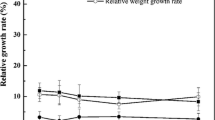Abstract
Investigations were carried out to determine the sites of lead uptake within the frond and the root ofLemna minor. With the sodium rhodizonate four regions favoured in lead uptake were distinguished: the frond region between the base and the node, the basal part of the root, and the regions at the proximal and distal ends of the root cap. For analysis in electron microscope only the root regions were chosen. The highest rate of lead uptake was found in the basal part of the root. Lead was present in the apoplast of this region after 5 min of exposure and was observed in the stelar cells after 30 min of incubation. Lead deposits were detected mostly in the cell walls adjacent to the plasma membrane and in the lumen of several endomembrane compartments - the endoplasmic reticulum (ER), dictyosomal vesicles, nuclear envelope and the vacuoles. Lead induced changes of cell ultrastructure; an increase in the number of membraneous structures, swelling of ER cisternae and distortion of the dictyosomal cisternae were observed after 2 to 6 h of exposure.
Similar content being viewed by others
References
Agami, M., Waisel, Y.: The ecophysiology of roots of submerged vascular plants. - Physiol. vég.24: 607–634, 1986.
Antonovics, J., Bradshaw, A.D., Turner, R.G.: Heavy metal tolerance in plants. - Adv. Ecol.7: 1–85, 1971.
Auriac, M.-C., Tort, M.: Ultrastructural evidence for a direct transport from apoplast to vacuoles in the storage cells of Japanese artichoke. - Physiol. vég.23: 301–307, 1985.
Bollard, E.E.: Comparative study of the ability of organic nitrogenous compounds to serve as a sole source of nitrogen for the growth of plants. - Plant Soil25: 153–166, 1966.
Cannon, H.L., Bowles, J.M.: Contamination of vegetation by tetraethyl lead. - Science137: 765–766, 1962.
Dörr, H., Munnich, K.O., Mangini A., Schmitz W.: Gasoline lead in West German soils. -Naturwissenschaft77: 428–430, 1990.
Foy, C.D., Chaney, R.L., White M.C.: The physiology of metal toxicity in plants. - Annu. Rev. Plant Physiol.29: 511–566, 1978.
Glater, F.A.B., Hernandez, L.: Lead detection in living plant tissue using a new histochemical method. - J. Air Pollut. Control Assoc.22: 463–467, 1972.
Hinesly, T.D., Jones, R.L., Ziegler, E.L.: Effects on corn by applications of heated anaerobically digested sludge. - Compost Sci.13: 26–30, 1972.
Idzikowska, K.: The effect of lead on the ultrastructure of root tip cells inPinus silvestris seedlings. - Bull. Soc. Amis Sci. Lett., Poznań30: 6–10, 1994.
Idzikowska, K.: Preliminary research on lead absorption and translocation in root tip cells ofPopulus nigra “Italica” Moench. - Acta Soc. Bot. Pol.2: 217–222, 1988.
Karnovsky, M.J.: A formaldehyde-glutaraldehyde fixative of high osmolarity for use in electron microscopy. - J. Cell Biol.27: 137–138, 1965.
Ksicazek, M., Woźny, A.: Lead movement in poplar adventitious roots. - Biol. Plant.32: 54–57, 1990.
Lane, S.D., Martin, E.S.: An ultrastructural examination of lead localization in germinating seeds ofRaphanus sativus. - Z. Pflanzenphysiol.107: 33–40, 1982.
Malone, C., Koeppe, D.E., Miller, R.J.: Localization of lead accumulated by corn plants. - Plant Physiol.53: 388–394, 1974.
Nriagu, J.O.: Global inventory of natural and anthropogenic emissions of trace metals to the atmosphere. -Nature279: 409–411, 1979.
Przymusiński, R., Woźny, A.: The reactions of lupin roots on the presence of lead in the medium. -Biochem. Physiol. Pflanz.180: 309–318, 1985.
Punz, W.F., Sieghardt, H.: The response of roots of herbaceous plant species to heavy metals. - Environ, exp. Bot.33: 85–95, 1993.
Romaniuk, J., Gabara, B.: Heavy metal action on the dry mass content and surface area of nuclei and cytoplasm during differentiation of cortex cells in pea (Pisum sativum L.) roots. - Folia histochem. cytochem.26: 263–274, 1988.
Slivinskaya, R.B.: Nickel effect on sunflower leaf cell membranes. - Acta bot. neerl.40: 133–138, 1991.
Smith, B.M.: An inter- and intra-agency survey of the use of plants for toxicity assessment. - In: Gorsuch, J.W., Lower, W.R., Wang, W., Lewis, M.A. (ed.): Plants for Toxicity Assessment: Second Volume. Pp. 41–59. American Society of Testing and Materials, Philadelphia 1991.
Spurr, A.R.: A low viscosity epoxy resin embedding medium for electron microscopy. - J. Ultrastruct. Res.26: 31–43, 1969.
Stoyanova, D.P., Tchakalova E.S.: The effect of lead and copper on the photosynthetic apparatus inElodea ccmadensis Rich. - Photosynthetica28: 63–74, 1993.
Tanton, T.W., Crowdy, S.H.: The distribution of lead chelate in the transpiration stream of higher plants. - Pestic. Sci.2: 211, 1971.
Wang, W.: Toxicity tests of aquatic pollutants by using common duckweed. - Environ. Pollut.11: 1–14, 1986.
Wierzbicka, M.: Lead accumulation and its translocation barriers in roots ofAllium cepa L. - autoradiographic and ultrastructural studies. - Plant Cell Environ.10: 17–26, 1987a.
Wierzbicka, M.: Lead translocation and localization inAllium cepa roots. - Can. J. Bot.65: 1851- 1860, 1987b.
Woźny, A.: [The Toxic Effects of Lead Compounds on Early Stages of Plant Development.] - Adam Mickiewicz University Press, Poznań 1987. [In Polish.]
Woźny, A., Gzyl J., Idzikowska K., Samardakiewicz S., Krzeslowska M.: Lead in the ultrastructure of plant cells. - Cell Biol. Int.18: 567, 1994.
Zimdahl, R.L., Koeppe, D.E.: Uptake by plants. - In: Boggess, W.R. (ed.): Lead in the Environment. Pp. 99–104. National Science Foundation, Washington 1977.
Author information
Authors and Affiliations
Additional information
We wish to thank Mrs. G. Winiecka for her technical assistance in preparing the photographs.
Rights and permissions
About this article
Cite this article
Kocjan, G., Samardakiewicz, S. & Woźny, A. Regions of lead uptake inLemna minor plants and localization of this metal within selected parts of the root. Biol Plant 38, 107–117 (1996). https://doi.org/10.1007/BF02879643
Received:
Accepted:
Issue Date:
DOI: https://doi.org/10.1007/BF02879643




